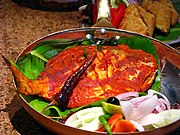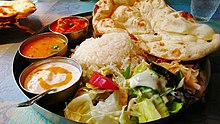Indian cooking derives from a 5000-year-old timeline, during which culture has changed, geographical boundaries have changed significantly leading to confusing terms such as sub-continental cuisine while other parts of a region want a separate culinary identity. Indian Cooking has however evolved significantly over time and the varying influences brought into the country by the various rulers and travelers, it has not lost its original identity, rather become richer with the assimilation of the myriad influences. This is very apparent in some of the unique regional cuisines.
Antiquity
The earliest formal civilizations were the Mohenjo-daro and Harappan civilizations. At around 3000 BCE, sesame, eggplant, and humped cattle had been domesticated in the Indus Valley, and spices like turmeric,cardamom, black pepper and mustard were harvested in this region concurrently. Many recipes first emerged during the initial Vedic period, when India was still heavily forested and agriculture was complemented with game hunting and forest produce. In Vedic times, a normal diet consisted of fruit, vegetables, meat, grain, dairy products and honey. Over time, some segments of the population embraced vegetarianism. This was facilitated by advent of Buddhism and a cooperative climate where variety of fruits, vegetables, and grains could easily be grown throughout the year. A food classification system that categorized any item as saatvic, raajsic or taamsic developed in Ayurveda. In this period vegetarianism also flourished throughout India, beef eating was prohibited which has become a long-standing feature in Hinduism and India.
Middle Ages
This period was the period of several North Indian dynasties, including the Gupta dynasty which was noted for its love of the arts; also known as the Golden Age of India Art. Travelers who visited India carried with them knowledge and products like tea and spices. Later India saw the period of Central Asian and Afghan conquerors. This period also saw the emergence of the Mughlai cuisine that people now associate with India. It includes the addition of several seasonings like saffron, the addition of nuts and cooking in the "Dum" or sealed pot method of cooking. 18th century saw the establishment of British rule in India. The British loved the elaborate way of eating and adapted several of the food choices to their taste and developed curry as a simple spice to help them cook dishes with Indian spice. This period resulted in the emergence of the Anglo-Indian cuisine and the emergence of certain "Raj" traditions like that of "high-tea" an elaborate late afternoon meal served with tea.





















